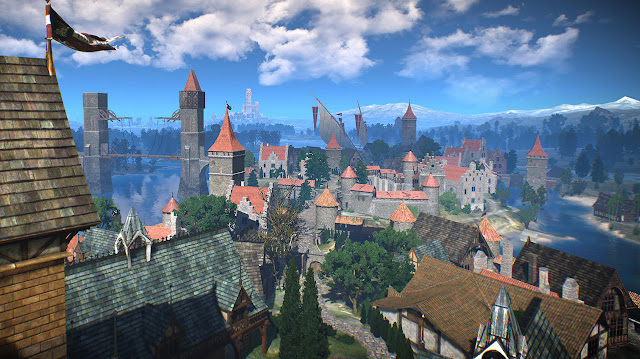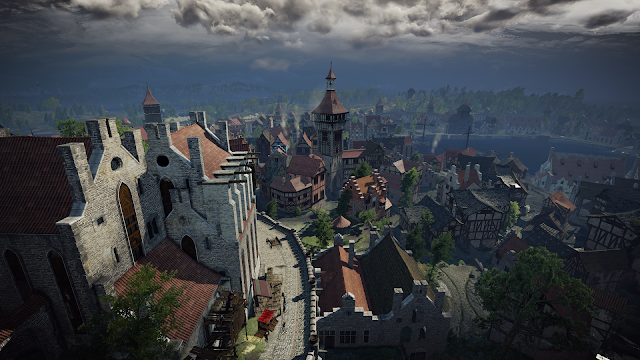What exactly sets Oxenfurt apart from Novigrad or Beauclair? In designing
The Witcher 3, the game’s developer, CD Projekt, made a clear effort to build cities which feel distinctly different. This involved giving them a unique sense of place.
We rarely distinguish between the two terms in everyday speech, but ‘space’ and ‘place’ are not actually synonymous. What’s the difference? Places are quite simply spaces into which people have introduced meaning through various processes of modification, transformation, and change. Spaces in other words can exist without people. Places can’t.
Referred to as placemaking, the shaping of space involves a transfer of ideas and values into the world around us. It occurs at several different scales. People for example can personalize individual apartments, but they can also modify entire landscapes. The shaping and reshaping of a city falls in between these two extremes. Reflecting the dominant attitudes of the people who inhabit them, cities are sites of cultural hegemony onto which the worldview of a society is written using the broadest imaginable terms. You can actually discover quite a bit about an urban community by carefully examining its environment. This holds true in video games, too.
What kinds of placemaking are observable in Oxenfurt? Built around its renowned university, three cultural values work to make it a place: power, privilege, and prestige. These come through pretty strongly in its architecture and urban planning, but the city’s impressive sanitation system speaks volumes, too.
 |
| Oxenfurt is very closely associated with its famous university |
Novigrad’s grit and grime is nowhere to be found in Oxenfurt. Things are in rather nice shape on the whole: the streets are clean, the shrubs are pruned, and the weeds have been largely beaten back. The contrast with Novigrad is altogether striking. The streets in Farcorners, Glory Lane, and the Bits for example are an absolute mess, but the city has bigger problems than just a little muck and mud. Rotting their mostly plaster walls, the sea spray has clearly taken its toll on the buildings in districts like Harborside and Lacehalls. The signs of water damage - mold, stains, and brown discoloration - aren’t easy to ignore. Propped up with some dubiously disguised wooden beams, Crippled Kate’s even seems like it’ll topple over at any moment. In comparison to the part of Oxenfurt near King Radovid’s galley, Harborside and Lacehalls definitely seem to be in a sorry state. The crumbling buildings in these two districts would surely have been long since demolished if they were in Oxenfurt.
 |
| Oxenfurt is pretty spick and span - even the harbor |
Oxenfurt’s pretensions affect more than just sanitation. Power, privilege, and prestige are echoed in the city’s materiality, too. While some parts of Novigrad are nothing but ramshackle huts, almost every building in its blue-blooded sister city is made from durable materials like stone and brick. These are clearly accessible to only the wealthiest people of Redania. Oxenfurt Academy is a good example of how certain types of construction material can take on associations of status: the hallowed halls of this elite institution are mostly masonry. Reflecting the social standing of its residents, the city as a whole is even characterized by its use of this material. The picture is completely different a little further down the Pontar. Novigrad has a few similar districts like Temple Isle and Gildorf, but the city is almost entirely made from a construction material known as wattle and daub: soil, clay, and straw held in place by a wooden lattice. (Animal dung is a common element as well). Sitting below a steep staircase leading into Gildorf, Marabella even passed on the plaster for her School for Tots: Novigrad’s only educational institution is just a log cabin. This humble structure is a pretty far cry from the stately Oxenfurt Academy.
 |
| The prestigious Oxenfurt Academy is mostly brick and stone |
They diverge in terms of materiality, but there’s a formal distinction as well between the two sister cities on the Pontar. The buildings in wealthy areas like Temple Isle and Gildorf show all the signs of planned construction, but Novigrad’s other districts are mainly characterized by architectural improvisation. Many of the houses in Glory Lane for example have been furnished with awkward additions along their outer walls like sheds, decks, and balconies. More than a handful even have supplementary rooms and floors. Few parts of Oxenfurt by contrast exhibit this characteristic. Most of its buildings adhere to well-established ordering principles like symmetry, hierarchy, and rhythm. This is definitely the case for Oxenfurt Academy, but it’s equally true for the dozens of brothels, shops, and houses down at the square. Whoreson Junior’s mansion is almost perfectly symmetrical in both plan and profile, but the best example of this phenomenon is actually the Borsodi Brothers’ Auction House. This latter structure is notable for two features: proportional hierarchy and decorative repetition. These can be deduced from elements like the oversized bay windows and ribbed facade.
 |
| The Borsodi Brothers' Auction House is elaborately designed |
This focus on order and structure even extends to the city’s urban planning. Similar to Beauclair, Oxenfurt is characterized by its well-defined paths, edges, nodes, and landmarks. (Check out
Building Novigrad for term definitions). These are some of the most basic elements of an urban space, but they’re not always recognizable on the ground. Novigrad for example has a number of districts like the Bits which lack strong instances of them. Oxenfurt by contrast has very clear instances of all four. Accommodating horses and high volumes of pedestrian traffic, the city’s broad boulevards make for highly distinguishable paths. The Pontar provides a pretty unambiguous edge, but this natural feature is even reinforced by several sets of man-made walls near Oxenfurt Academy. Situated between the city’s two gates, the bustling market also makes for a pretty unmistakable node. Landmarks are plentiful, too: Guildenstern Bridge, Oxenfurt Academy, and the Borsodi Brothers’ Auction House are all easily identifiable from a distance. In contrast to the Bits, the clarity of these paths, edges, nodes, and landmarks prevents the city from seeming like an undifferentiated mass of buildings.
 |
| The street system in Oxenfurt is relatively well ordered |
Oxenfurt is very much a reflection of its inhabitants. Shaped by members of Redania’s highest elite, the city is deeply imbued with cultural values like power, privilege, and prestige. These influenced various aspects of its architecture, urban planning, and even sanitation. This brand of worldbuilding was all in a day’s work for CD Projekt, though. Establishing how exactly it differs from other cities like Novigrad or Beauclair, Oxenfurt was given a unique identity which pervades every aspect of its physical existence in the game world. Oxenfurt in other words was given a sense of place. Contributing enormously to the overall experience which the game has to offer, such depth and detail goes a long way towards making
The Witcher 3 stand out from other games of its genre. Few until now have been able to attain this high a level of realism and consistency. Hopefully more will.








